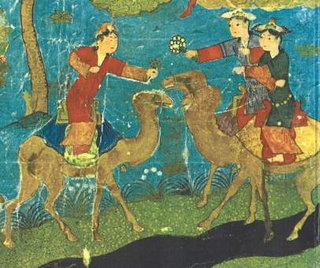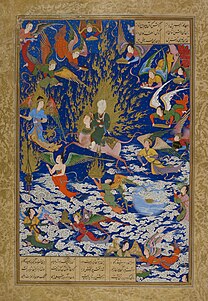
In Islamic religious belief, houris are women who will accompany faithful Muslim believers in Paradise. Muslim scholars differ as to whether they refer to the believing women of this world or a separate creation, with the majority opting for the latter.

Hud was a prophet of ancient Arabia mentioned in the Quran. The eleventh chapter of the Quran, Hud or Hoodh, is named after him, though the narrative of Hud comprises only a small portion of the chapter.

Yusuf ibn Yaqub ibn Ishaaq ibn Ibrahim is a prophet mentioned in the Quran, and corresponds to Joseph, a person from the Tanakh, the Jewish religious scripture, and the Christian Bible, who was estimated to have lived in Egypt before the New Kingdom. It is one of the common names in the Middle East and among Muslim nations. Of all of Jacob's children, Joseph was the one given the gift of prophecy. Although the narratives of other prophets are mentioned in various Surahs, the complete narrative of Joseph is given only in one Surah, Yusuf, making it unique. It is said to be the most detailed narrative in the Qur'an and bears more details than the Biblical counterpart.

The Israʾ and Miʿraj are the two parts of a Night Journey that, according to Islam, the prophet Muhammad (570–632) took during a single night around the year 621. Within Islam it signifies both a physical and spiritual journey. A brief sketch of the story is in the Quran surah al-Isra, while greater detail is found in the hadith; later collections of the reports, teachings, deeds and sayings of Muhammad.

Al-Ikhlāṣ, also known as the Declaration of God's Unity and al-Tawhid, is the 112th chapter (sūrah) of the Quran.

Al-Mu’minun is the 23rd chapter (sūrah) of the Qur'an with 118 verses (āyāt). Regarding the timing and contextual background of the supposed revelation, it is an earlier "Meccan surah", which means it is believed to have been revealed in Mecca, instead of later in Medina.

Ash-Shu‘ara’ is the 26th chapter (sūrah) of the Qurʾan with 227 verses (āyāt). Many of these verses are very short. The chapter is named from the word Ash-Shu'ara in ayat 224.

Al-Qamar is the 54th chapter (surah) of the Quran, with 55 verses (ayat). Some verses refer to the Splitting of the moon. "Qamar" (قمر), meaning "Moon" in Arabic, is also a common name among Muslims.

Al-Jinn is the 72nd chapter (sūrah) of the Quran with 28 verses (āyāt). The name as well as the topic of this chapter is jinn. Similar to angels, the jinn are beings invisible to the naked human eye. In the Quran, it is stated in more than one instance that humans are created from the earth and jinn from smokeless fire.

Ash-Shams is the 91st surah of the Qur'an, with 15 ayat or verses. It opens with a series of solemn oaths sworn on various astronomical phenomena, the first of which, "by the sun", gives the sura its name, then on the human soul itself. It then describes the fate of Thamud, a formerly prosperous but now extinct Arab tribe. The prophet Saleh urged them to worship God alone, and commanded them in God's name to preserve a certain she-camel; they disobeyed and continued to reject his message; they killed the she-camel and God destroyed them all except those who had followed Salih.

A number of terms are used in Islam to refer to the claims of events happening that are not explicable by natural or scientific laws, subjects where people sometimes invoke the supernatural. In the Quran the term āyah refers to signs in the context of miracles of God's creation and of the prophets and messengers. In later Islamic sources miracles of the prophets were referred to by Muʿjiza, while miracles of saints are referred to as karamat (charismata). I'jaz al-Quran – literally the inimitability of the Quran – refers to the Quranic claim that no one can hope to imitate its perfection, this quality being considered the primary miracle of the Quran and proof of Muhammad's prophethood. In recent decades, "I'jaz" has also come to refer to the belief that the Quran contains what believers call "scientific miracles", i.e. prophecies of scientific discoveries. Kharq al`adad – "a break in God's customary order of things" – was a term used in "theological or philosophical discussions" to refer to miraculous events. Karamat – "gifts or graces" – was usually used for miraculous performances of Sufi saints often used to convert unbelievers to Islam.

An-Nisa 4:34 is the 34th verse in the fourth chapter of the Quran. This verse discusses the husband's role as protector and maintainer of his wife and how he should deal with disloyalty on her part. Scholars vastly differ on the implications of this verse, with many Muslim apologists arguing that it serves as a deterrent from anger-based domestic violence; whereas some Muslims, such as Islamic feminist groups, argue that the text is a justification for domestic violence. The translation of the verse is also subject to debate among Muslim scholars, which can read 'strike them [wives]' or '(lightly) strike them' or 'beat them' or 'scourge them', depending on the translator. Furthermore, as that said in a hadith transmitted by Abu Huraira, slapping someone across their face was forbidden.

Miracles of Muhammad, according to Muslims, refers to the Islamic religious teaching that the Islamic prophet Muhammad performed miracles during his lifetime. These teachings stem from the text of the Quran, hadith, and biographies of him. Almost all the miracles come from the hadith as the vast majority are either not mentioned or what makes them miraculous is not mentioned in the Quran.
Abdullah ibn Umm-Maktum was, according to Ibn Kathir (d.1373), a companion of Islamic prophet Muhammad. In some traditions his name has also appeared as `Amr ibn Umm-Maktum. The first verses of He Frowned, the 80th chapter of Qur'an, are considered to be revealed in an incident connected to him.

ʾIdrīs is an ancient prophet mentioned in the Quran, whom Muslims believe was the third prophet after Seth. He is the second prophet mentioned in the Quran. Islamic tradition has unanimously identified Idris with the biblical Enoch, although many Muslim scholars of the classical and medieval periods also held that Idris and Hermes Trismegistus were the same person.

Al-masad (Arabic: ألْمَسَدْ, is the 111th chapter of the Quran. It has 5 āyāt or verses and recounts the punishments that Abū Lahab and his wife will suffer in Hell.

Prophets in Islam are individuals in Islam who are believed to spread God's message on Earth and to serve as models of ideal human behaviour. Some prophets are categorized as messengers, those who transmit divine revelation, most of them through the interaction of an angel. Muslims believe that many prophets existed, including many not mentioned in the Quran. The Quran states: "There is a Messenger for every community". Belief in the Islamic prophets is one of the six articles of the Islamic faith.

The names and titles of Muhammad, names and attributes of Muhammad, Names of Muhammad are the names of the Islamic prophet Muhammad and used by Muslims, where 88 of them are commonly known, but also countless names which are found mainly in the Quran and hadith literature. The Quran addresses Muhammad in the second person by various appellations; prophet, messenger, servant of God (abd).

The Warning Verse is verse 214 of the Quran's 26th chapter, Ash-Shu'ara (Q26:214). According to Islamic tradition, it was revealed to Muhammad in the third year of his prophetic mission, and instructed him to encourage his relatives to convert to Islam.

The challenge of the Quran, in Islamic theology, refers to a challenge proposed in the Quran. It requests non-Muslims among both humans and jinn to produce either a chapter or multiple chapters like those within the holy book, with the aim of proving the Quran's superiority over any work. Quran 2:23-24 says that this is impossible to achieve.













